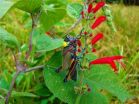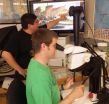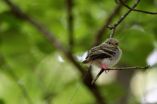(Press-News.org) A newly discovered grasshopper by University of Central Florida scientists now bears the name of Grammy-award winning singer and activist Ana Lila Downs Sanchez.
The scientists named the new species discovered on the side of a mountain road near Oaxaca, Mexico, after the Mexican-American singer as a nod to her efforts to preserve indigenous culture and penchant for wearing colorful, local costumes as part of her performances.
"It was primarily Paolo's idea to name the grasshopper after the singer" said Derek Woller, one of the authors of the paper referring to colleague Paolo Fontana. "He's a big fan of Lila Downs (her stage name). The grasshopper is so beautiful, so vibrant and colorful. When he told us all about her, her work, her colorful clothes, and that she was born in the region where we found the specimens, we thought, yeah, that's great, let's do it."
The grasshopper measures about an inch long on average and resembles a fiery rainbow with blue, red, yellow, orange and black markings. The first pictures of the new species make their debut in an article in this month's Zootaxa journal. http://www.mapress.com/zootaxa/2014/f/zt03793p495.pdf
Woller, Fontana, Ricardo Mariño-Pérez and Hojun Song are the authors of the paper. Woller is a Ph.D. candidate and Mariño-Pérez is a Ph.D. student in Biology Professor Song's lab while Fontana is a researcher at the Edmund Mach Foundation in Pergine Valsugana, Italy.
The men were doing fieldwork for another grasshopper study in a pine-oak forest of the Sierra Madre del Sur Mountain Range in Oaxaca, Mexico, when they came across their discovery in 2011.
"We were surprised that a grasshopper of that size and found next to the road wasn't discovered before," Mariño-Pérez said.
The team did some research, returned again in 2013 to see if they could find more grasshoppers and then submitted their work to the journal after confirming three known small populations of the creatures.
There are about 9,700 known species of grasshoppers in the world. UCF houses many examples in its Bug Closet, which now also contains the Lila Downs friar grasshopper.
Locals called the creature the friar grasshopper because its head looks a bit like what a monk with his hood pulled back might look like. In Spanish "friale" means friar. That's why the full scientific name of the grasshopper is Liladownsia fraile.
For the UCF team, it was important to recognize Mexico in naming the species. Downs is known for her contributions to the music industry through her traditional fashion, which is primarily based on Mexico's indigenous communities, cultures and heritages. Her music has earned her a Grammy Award and two Latin Grammy Awards. She's active with various humanitarian causes especially those related to Latin America's indigenous communities. But most young music fans may recognize her because she was a featured artist on Carlos Santana's "Corazon" album with Gloria Estefan, Ziggy Marley, Wayne Shorter and others released earlier this year.
The team's journal article includes a paragraph giving Lila Downs kudos for her work.
"This taxon is dedicated to (Lila Downs) for a number of reasons, such as the fact that she was born in the vicinity of the type locality and because she incorporates several indigenous tongues from Mexico into her musical style, including Mixteco and Zapoteco (the latter of which is spoken in the type locality). Additionally, Lila Downs has not only promoted the vast cultural diversity of Mexico worldwide via her music, but also through the use of bright colors, a staple of Mexican culture, and considering that this new genus is brightly colored, we would like to recognize her efforts through the dedication of this new genus."
Mariño-Pérez said the discovery of the grasshopper is an important reminder to all of us to be mindful of the way we use our planet.
"We are in a era of biodiversity crisis," he said. "Every day species are disappearing, in some cases even before being discovered. This discovery is a reminder that new species are not only in the middle of the Amazon or in the deep forests of Africa but also next to the road in a more or less populated area."
To assist in supporting the conservation cause, this unique grasshopper species has been placed on the International Union for Conservation of Nature's new Red List of threatened species.
INFORMATION:
America's Partnership University: The University of Central Florida, the nation's second-largest university with nearly 60,000 students, has grown in size, quality, diversity and reputation in its first 50 years. Today, the university offers more than 200 degree programs at its main campus in Orlando and more than a dozen other locations. UCF is an economic engine attracting and supporting industries vital to the region's future while providing students with real-world experiences that help them succeed after graduation. For more information, visit http://today.ucf.edu.
New grasshopper species named after Grammy winner
2014-05-08
ELSE PRESS RELEASES FROM THIS DATE:
Obesity drug failing patients due to lack of education about side-effects
2014-05-08
A new study, published today in the Journal of Health Psychology, found that patients who gained weight 18 months after taking Orlistat attributed their weight-loss failure either to the side effects which have prevented them from sticking to the medication or felt that the medication simply had not worked.
The team from the University of Surrey also found that participants described a series of barriers to weight loss including psychological and physical health issues, relationships and the make-up of their bodies. They also described a number of alternative methods ...
Urine test best detects alcohol use in liver transplant candidates, recipients
2014-05-08
Researchers from Italy confirm that urinary ethyl glucuronide (uEtG) accurately detects alcohol consumption in liver transplant candidates and recipients. The study published in Liver Transplantation, a journal of the American Association for the Study of Liver Diseases and the International Liver Transplantation Society, suggests that a combination of uEtG and the Alcohol Use Disorders Identification Test for alcohol consumption (AUDIT-c) are best in alerting doctors to alcohol consumption by patients undergoing evaluation for liver transplantation or who have received ...
Breakthrough made at Max F. Perutz Laboratories
2014-05-08
Researchers at the Max F. Perutz Laboratories (MFPL) of the University of Vienna and the Medical University of Vienna made a breakthrough for the Platynereis model system, as they describe the first method for generating specific and inheritable mutations in the species. The method, in combination with other tools, now places this marine bristle worm in an excellent position to advance research at the frontiers of neurobiology, chronobiology, evolutionary developmental biology and marine biology. The study and a review on Platynereis dumerilii genetic methods were chosen ...
Fungus may help stop invasive spread of tree-of-heaven
2014-05-08
A naturally occurring fungus might help curb the spread of an invasive tree species that is threatening forests in most of the United States, according to researchers.
Researchers tested the fungus -- Verticillium nonalfalfae -- by injecting it into tree-of-heaven, or Ailanthus, plots, according to Matthew Kasson, who recently received his doctorate in plant pathology and environmental microbiology from Penn State. The treatment completely eradicated the tree-of-heaven plants in those forests.
"It appears that this treatment is effective in Pennsylvania and could ...
New paper provides important insights into carcinoma-associated fibroblasts
2014-05-08
A new paper by a team of researchers led by Zachary T. Schafer, Coleman Assistant Professor of Cancer Biology in the Department of Biological Sciences at the University of Notre Dame, offers important new insights into the role carcinoma-associated fibroblasts (CAFs) play in tumor biology. A number of recent studies have revealed CAFs to be a major contributor to tumor progression through a variety of mechanisms. Despite this information, the precise role CAFs play in augmenting the growth of tumors is still poorly understood.
In their new paper, Schafer and his fellow ...
'Teenage' songbirds experience high mortality due to many causes, MU study finds
2014-05-08
Nearly one-third of songbird species across North America are experiencing long-term declines. Scientists have spent years researching potential causes for these population declines, focusing on the birds when they have just hatched as well as when they are adults. Now, researchers from the University of Missouri and the U.S. Department of Agriculture have found that songbirds are vulnerable to environmental dangers particularly when they are juveniles, shortly after they have left their parents' nests. Frank Thompson, a scientist with the USDA Forest Service and an associate ...
Hepatitis C virus: How viral proteins interact in human cells
2014-05-08
Viruses use human cells in order to multiply and spread. This process involves interactions with cellular host factors as well as virus-virus interactions. For example interactions among viral proteins are essential for the assembly of newly produced infectious virions.
Interaction network explains viral mechanisms and opens up possibilities for new treatments
Hepatitis C virus (HCV) forms a precursor protein, which is processed into ten viral proteins. Scientists at the Institute of Virology at the Helmholtz Zentrum have now discovered how these proteins interact with ...
Promising role for interleukin-10 in scarless wound healing
2014-05-08
New Rochelle, NY, May 8, 2014—The powerful anti-inflammatory compound interleukin-10 (IL-10) plays a crucial role in regenerative, scarless healing of fetal skin. Studies of IL-10 in postnatal skin wounds have demonstrated its promise as an anti-scarring therapeutic agent, as described in a Critical Review article published in Advances in Wound Care, a monthly peer-reviewed journal from Mary Ann Liebert, Inc., publishers and an Official Journal of the Wound Healing Society. The article is available free on the Advances in Wound Care website.
In "Regenerative Wound Healing: ...
Detecting trace amounts of explosives with light
2014-05-08
University of Adelaide research may help in the fight against terrorism with the creation of a sensor that can detect tiny quantities of explosives with the use of light and special glass fibres.
Published in the journal Sensors and Actuators B: Chemical, the researchers describe a novel optical fibre sensor which can detect explosives in concentrations as low as 6.3 ppm (parts per million). It requires an analysis time of only a few minutes.
"Traditionally explosives detection has involved looking for metals that encase them such as in land mines," says project leader ...
'Parent' cells reset the cell division clock
2014-05-08
Melbourne researchers have overturned a 40-year-old theory on when and how cells divide, showing that 'parent' cells program a cell division time for their offspring that is different from their own.
Scientists from the Walter and Eliza Hall Institute have shown that both phases of the cell cycle contribute to the overall change in division time rather than one staying fixed in duration as previously thought. They have developed these findings into a new model that helps scientists predict how a population of cells has divided.
Their research could impact our understanding ...





